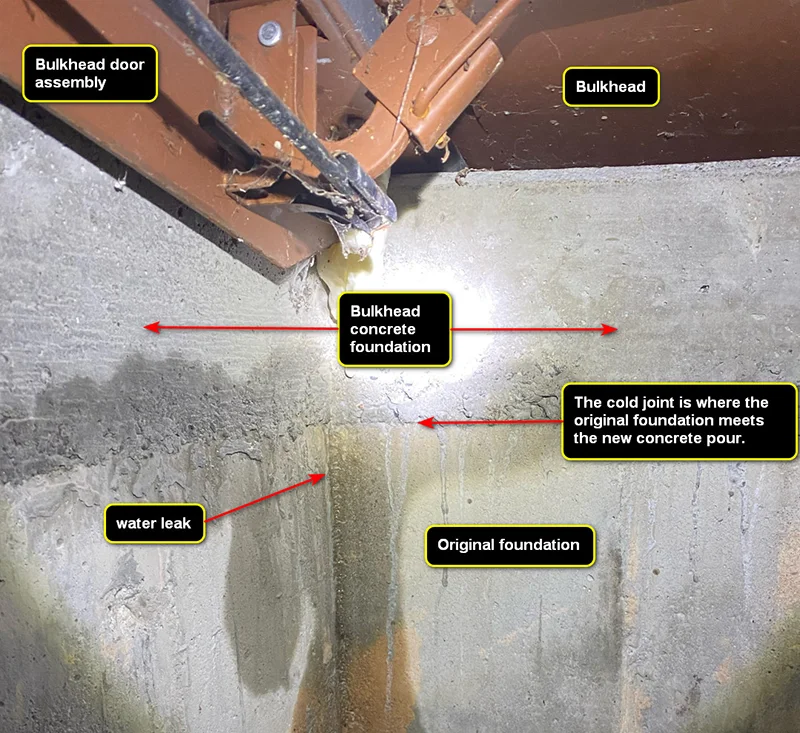In this episode, Adam shares an interesting case study about a bulkhead with a cold joint and how he solved this mysterious leak.

Narrator: It’s time once again for the “Crack Man Podcast” hosted by A1 Foundation Crack Repair. I’m Darren Kincaid here with the Crack Daddy himself, Adam Tracy. Adam and The Crack Man Rich have over 30 years’ experience in the construction industry. Rich as over two5 years as the president and founder of A1 Foundation Crack Repair. This podcast provides expert basement waterproofing, concrete repair, and preventative maintenance tips for homeowners and businesses. A1 Foundation’s valuable insight will help avert a disastrous flood within the basement, health problems associated with water infiltration, and protect your biggest investment….your home. The topic of today’s podcast: The case of the bulkhead with a cold joint.
Narrator: So, Adam, we love your case studies, and this one sounds like a mystery novel. What happened here?
Adam: Yeah. This is a good case for people that have an existing bulkhead situation where they've had leaks or they've moved into a house, and they've seen that there's been some modifications done to their bulkheads. Now we don't see this every day, but it's something that's common enough for most homeowners who should be aware of it, especially if you're looking at a new home here to buy.
Often when we see a foundation bulkhead leaking, it could be coming in one of two areas primarily. It could be coming in where the metal cap of the bulkhead, the doors of the bulkhead attached to the concrete, or it could be also where the concrete attaches to the concrete of the foundation. Now we've talked about waterproofing that seam of the concrete-to-concrete transition, but a lot of times that bulkhead up top that metal bulkhead has some challenges there. And those challenges are typically that there's not enough room between the soil outside and the metal doors.
Any water that may accumulate or puddle or snow that may melt can get underneath that seam and flood in there. A lot of people will just cock the inside and outside, and that will take care of a lot of situations, but in certain cases, the bulkhead door might need to be removed, and a cap might need to be put on there. So, what happens is rather than regrading your entire landscaping or breaking up a patio that might be right nearby, the bulkhead metal doors would come off and then a lip of anywhere from 2 to 6 inches of concrete would be poured on top of the existing foundation or potentially a concrete cinder block would be added around there, and then the cap would be reset.
What that does is it allows it to be elevated above the door so the doors don't rust, and you have deterioration there. The challenge is that you have concrete to concrete transition of one that is existing and one that is new, and that is a cold joint just like we have with an addition. And so, a lot of times that same problem that we had previously where it was leaking through the door is now leaking through the concrete because you haven't regraded the situation. You've just moved the bulkhead door up in the elevation a little bit. So just like we would do on a concrete cold joint and an addition situation where it's a vertical joint, we would drill into the foundation and intersect that and use our high-pressure pumps to inject a closed-cell polymer resin material that would seal that cap from the inside out.
Sometimes when it's a cinder block foundation cap that's on top of the existing concrete, we'd have to do the same situation and drill into there and kind of flood the individual cells with waterproofing material and then recap it on the interior and exterior with the masonry material to help kind of fortify it. So while it is very good and generally recommended to lift that door up so that way it's not sitting in a puddle every time it rains, it's to make sure that you actually physically waterproof that joint because more often than not over the years that joint deteriorates and then it ends up being in a leak.
The water just comes right into your finished basement or unfinished basement, but obviously an issue. So it's a simple repair. It's just something that we need to diagnose with you. And if you see something like this, when you're looking at a house, either to sell it or buy it, make sure that it's been waterproof properly.
Narrator: Well, thanks, Adam, for sharing this interesting case study about the bulkhead with a cold joint and how you solve this mystery. It sounds like you nab your villain.
Narrator: If you have a basement water problem and think you need a professional, or, if you’d like more information on foundation crack repair and basement waterproofing topics, please visit A1FoundationCrackRepair.com or call Rich at (866) 92 9-3171. Or you can email Rich at info@a1foundationcrackrepair.com. Thanks for listening and keep that basement dry.

